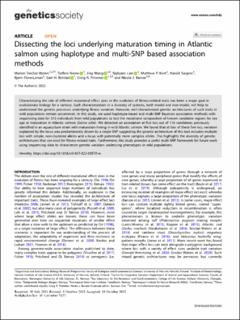| dc.contributor.author | Sinclair-Waters, Marion | |
| dc.contributor.author | Nome, Torfinn | |
| dc.contributor.author | Wang, Jing | |
| dc.contributor.author | Lien, Sigbjørn | |
| dc.contributor.author | Kent, Matthew Peter | |
| dc.contributor.author | Sægrov, Harald | |
| dc.contributor.author | Florø-Larsen, Bjørn | |
| dc.contributor.author | Bolstad, Geir Hysing | |
| dc.contributor.author | Primmer, Craig R. | |
| dc.date.accessioned | 2022-12-08T13:58:26Z | |
| dc.date.available | 2022-12-08T13:58:26Z | |
| dc.date.created | 2022-11-21T13:59:44Z | |
| dc.date.issued | 2022 | |
| dc.identifier.citation | Heredity. 2022, 129, 356–365. | en_US |
| dc.identifier.issn | 0018-067X | |
| dc.identifier.uri | https://hdl.handle.net/11250/3036841 | |
| dc.description.abstract | Characterizing the role of different mutational effect sizes in the evolution of fitness-related traits has been a major goal in volutionary biology for a century. Such characterization in a diversity of systems, both model and non-model, will help to understand the genetic processes underlying fitness variation. However, well-characterized genetic architectures of such traits in wild populations remain uncommon. In this study, we used haplotype-based and multi-SNP Bayesian association methods with sequencing data for 313 individuals from wild populations to test the mutational composition of known candidate regions for sea age at maturation in Atlantic salmon (Salmo salar). We detected an association at five loci out of 116 candidates previously identified in an aquaculture strain with maturation timing in wild Atlantic salmon. We found that at four of these five loci, variation explained by the locus was predominantly driven by a single SNP suggesting the genetic architecture of this trait includes multiple loci with simple, non-clustered alleles and a locus with potentially more complex alleles. This highlights the diversity of genetic architectures that can exist for fitness-related traits. Furthermore, this study provides a useful multi-SNP framework for future work using sequencing data to characterize genetic variation underlying phenotypes in wild populations. | |
| dc.language.iso | eng | en_US |
| dc.title | Dissecting the loci underlying maturation timing in Atlantic salmon using haplotype and multi-SNP based association methods | en_US |
| dc.title.alternative | Dissecting the loci underlying maturation timing in Atlantic salmon using haplotype and multi-SNP based association methods | en_US |
| dc.type | Journal article | en_US |
| dc.type | Peer reviewed | en_US |
| dc.description.version | publishedVersion | |
| dc.subject.nsi | VDP::Zoologiske og botaniske fag: 480 | |
| dc.subject.nsi | VDP::Zoology and botany: 480 | |
| dc.source.journal | Heredity | en_US |
| dc.identifier.doi | 10.1038/s41437-022-00570-w | |
| dc.identifier.cristin | 2077404 | |
| dc.relation.project | Andre: Academy of Finland (grant numbers 307593, 302873 and 327255) | |
| dc.relation.project | Norges forskningsråd: 275862 | |
| dc.relation.project | Andre: Research Council of Canada | |
| dc.relation.project | Norges forskningsråd: 275310 | |
| cristin.ispublished | true | |
| cristin.fulltext | original | |
| cristin.qualitycode | 1 | |
